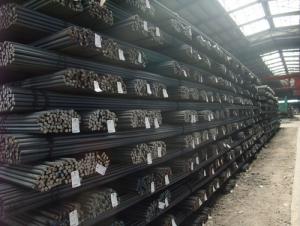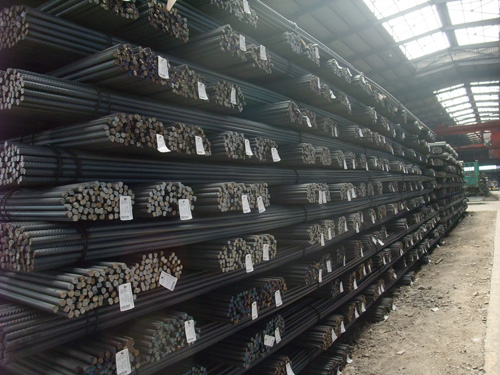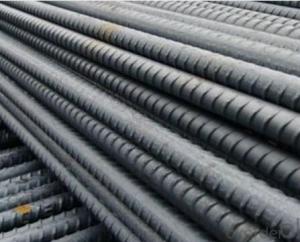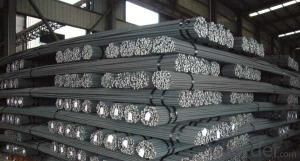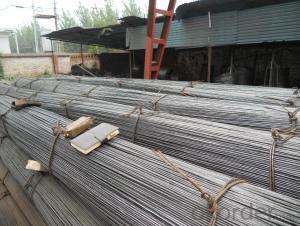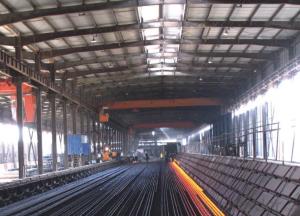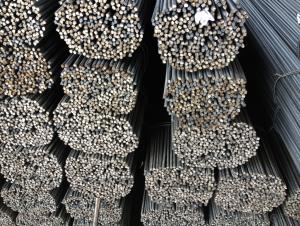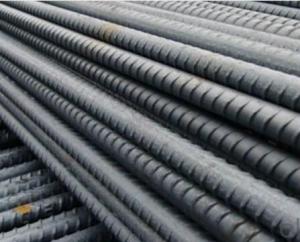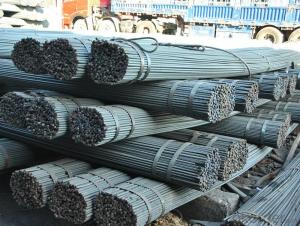Steel Rebar Deformed Bar High Quality Hot Rolled Steel
- Loading Port:
- China Main Port
- Payment Terms:
- TT or LC
- Min Order Qty:
- -
- Supply Capability:
- -
OKorder Service Pledge
OKorder Financial Service
You Might Also Like
Product Description:
OKorder is offering Steel Rebar Deformed Bar High Quality Hot Rolled Steelat great prices with worldwide shipping. Our supplier is a world-class manufacturer of steel, with our products utilized the world over. OKorder annually supplies products to European, North American and Asian markets. We provide quotations within 24 hours of receiving an inquiry and guarantee competitive prices.
Product Applications:
Steel Rebar Deformed Bar High Quality Hot Rolled Steel are ideal for structural applications and are widely used in the construction of buildings and bridges, and the manufacturing, petrochemical, and transportation industries.
Product Advantages:
OKorder's Steel Rebar Deformed Bar High Quality Hot Rolled Steel are durable, strong, and resist corrosion.
Main Product Features:
· Premium quality
· Prompt delivery & seaworthy packing (30 days after receiving deposit)
· Corrosion resistance
· Can be recycled and reused
· Mill test certification
· Professional Service
· Competitive pricing
Product Specifications:
Specifications of HRB500 Deformed Steel Bar:
Standard | GB | HRB500 |
Diameter | 6mm,8mm,10mm,12mm,14mm,16mm,18mm,20mm, 22mm,25mm,28mm,32mm,36mm,40mm,50mm | |
Length | 6M, 9M,12M or as required | |
Payment term | TT or L/C | |
Application | mainly used in construction industry to reinforce concrete structures and so on | |
Quality | First quality, the goods are from Chinese big manufacturers. | |
Type | Hot rolled deformed steel bar | |
Brand name | DRAGON | |
Chemical Composition: (Please kindly find our chemistry of our material based on HRB500 as below for your information)
Grade | Technical data of the original chemical composition (%) | ||||||
C | Mn | Si | S | P | V | ||
HRB500 | ≤0.25 | ≤1.60 | ≤0.80 | ≤0.045 | ≤0.045 | 0.08-0.12 | |
Physical capability | |||||||
Yield Strength (N/cm²) | Tensile Strength (N/cm²) | Elongation (%) | |||||
≥500 | ≥630 | ≥12 | |||||
Theoretical weight and section area of each diameter as below for your information:
Diameter(mm) | Section area (mm²) | Mass(kg/m) | Weight of 12m bar(kg) |
6 | 28.27 | 0.222 | 2.664 |
8 | 50.27 | 0.395 | 4.74 |
10 | 78.54 | 0.617 | 7.404 |
12 | 113.1 | 0.888 | 10.656 |
14 | 153.9 | 1.21 | 14.52 |
16 | 201.1 | 1.58 | 18.96 |
18 | 254.5 | 2.00 | 24 |
20 | 314.2 | 2.47 | 29.64 |
22 | 380.1 | 2.98 | 35.76 |
25 | 490.9 | 3.85 | 46.2 |
28 | 615.8 | 4.83 | 57.96 |
32 | 804.2 | 6.31 | 75.72 |
36 | 1018 | 7.99 | 98.88 |
40 | 1257 | 9.87 | 118.44 |
50 | 1964 | 15.42 | 185.04 |
Usage and Applications of HRB500 Deformed Steel Bar:
Deformed bar is widely used in buildings, bridges, roads and other engineering construction. Big to highways, railways, bridges, culverts, tunnels, public facilities such as flood control, dam, small to housing construction, beam, column, wall and the foundation of the plate, deformed bar is an integral structure material. With the development of world economy and the vigorous development of infrastructure construction, real estate, the demand for deformed bar will be larger and larger..
Packaging & Delivery of HRB500 Deformed Steel Bar:
Packaging Detail: products are packed in bundle and then shipped by container or bulk vessel, deformed bar is usually naked strapping delivery, when storing, please pay attention to moisture proof. The performance of rust will produce adverse effect.
Each bundle weight: 2-3MT, or as required
Delivery Detail: within 45 days after received advanced payment or LC.
Label: to be specified by customer, generally, each bundle has 1-2 labels
Trade terms: FOB, CFR, CIF
FAQ:
Q1: How do we guarantee the quality of our products?
A1: We have established an advanced quality management system which conducts strict quality tests at every step, from raw materials to the final product. At the same time, we provide extensive follow-up service assurances as required.
Q2: How soon can we receive the product after purchase?
A2: Within three days of placing an order, we will begin production. The specific shipping date is dependent upon international and government factors, but is typically 7 to 10 workdays.
Q3: Can stainless steel rust?
A3: Stainless does not "rust" as you think of regular steel rusting with a red oxide on the surface that flakes off. If you see red rust it is probably due to some iron particles that have contaminated the surface of the stainless steel and it is these iron particles that are rusting. Look at the source of the rusting and see if you can remove it from the surface.
Images:
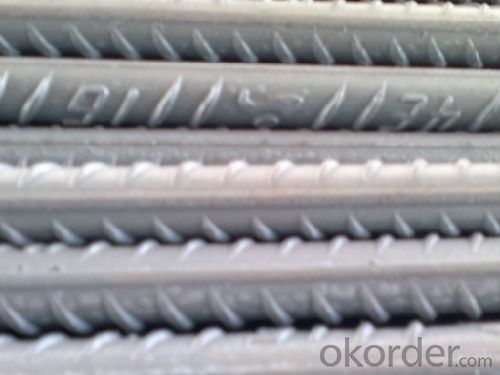
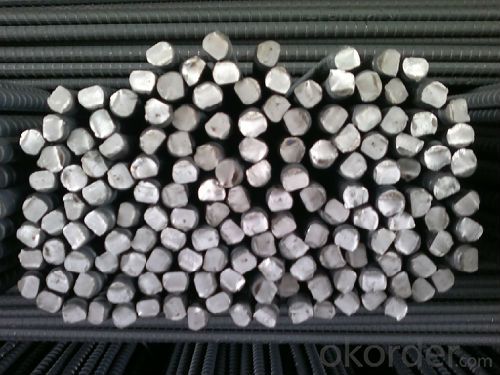
- Q: How do steel rebars affect the overall weight of a concrete structure?
- Steel rebars are an essential component in reinforcing concrete structures, and they play a significant role in determining the overall weight of the structure. Rebars are typically made of carbon steel, which is known for its high strength and durability. When mixed with concrete, rebars provide tensile strength to counterbalance the concrete's compressive strength. The addition of steel rebars to a concrete structure increases its weight. However, the impact on the overall weight is relatively minimal compared to the benefits they provide. The weight of steel rebars is significantly lower than that of concrete, but their inclusion does contribute to the total weight. The primary purpose of steel rebars is to reinforce the concrete, ensuring that it can bear the loads and stresses imposed on the structure. By distributing the tensile forces throughout the concrete, rebars prevent cracking and structural failure. This reinforcement allows for the construction of larger and more robust structures, such as bridges, buildings, and highways. Although the weight of steel rebars increases the overall weight of a concrete structure, it is a necessary trade-off for enhanced strength and durability. The additional weight from the rebars is typically insignificant compared to the weight of the concrete itself. Moreover, the increased weight is often negligible when considering the overall load-bearing capacity and structural integrity of the entire construction. In summary, steel rebars contribute to the overall weight of a concrete structure, but the impact is relatively minor compared to the benefits they provide. The reinforcement provided by rebars ensures the structural integrity and durability of the concrete while allowing for the construction of larger, safer, and more resilient structures.
- Q: How are steel rebars marked for identification on construction sites?
- Steel rebars are typically marked for identification on construction sites using a variety of methods. The most common method is through the use of tags or labels that are attached to the rebars. These tags often contain important information such as the diameter, grade, and length of the rebar, as well as any additional specifications or codes that may be required. In addition to tags, rebars may also be marked using paint or ink. This can be done by either spraying or stenciling the required information directly onto the surface of the rebar. Paint or ink markings are often used for temporary identification purposes or when tags are not feasible. Another method of marking rebars is through the use of colored plastic or vinyl caps. These caps are placed on the ends of the rebars and are typically color-coded to indicate various characteristics such as the size or type of rebar. This method allows for quick and easy visual identification on the construction site. It is important to note that the specific method of marking rebars may vary depending on local regulations, project requirements, or the preferences of the construction company or engineer. The goal of these markings is to ensure that rebars can be easily identified and sorted during construction, helping to ensure proper installation and adherence to design specifications.
- Q: Can steel rebars be used in the construction of underground parking structures?
- Steel rebars are an effective choice for constructing underground parking structures. They are commonly used in reinforced concrete structures, such as underground parking, to reinforce and provide tensile strength. The rebars are strategically placed within the concrete to enhance its load-bearing capacity, durability, and resistance to cracking or deformation. Steel rebars are ideal for underground parking structures that require strong structural support, thanks to their high strength and ability to withstand heavy loads. To further enhance their resistance to corrosion, protective coatings or stainless steel rebars can be applied, which is particularly important in underground environments with moisture and exposure to chemicals. Ultimately, the use of steel rebars is a standard practice in constructing underground parking structures to ensure long-lasting structural integrity.
- Q: What is the role of steel rebars in road bridge construction?
- Steel rebars are used in road bridge construction to provide reinforcement and strength to the concrete structures. They are embedded within the concrete to help distribute and bear the load, ensuring the bridge's durability and structural integrity. The rebars help to prevent cracking and improve the overall strength of the bridge, making it capable of withstanding heavy traffic loads and adverse weather conditions.
- Q: How do steel rebars contribute to the overall structural integrity of a building?
- Steel rebars, also known as reinforcement bars, play a crucial role in enhancing the overall structural integrity of a building. They are embedded within concrete structures to provide tensile strength, which complements the compressive strength of the concrete. By resisting tension forces, steel rebars help prevent cracks and failure in the concrete, ensuring the structural stability and durability of the building.
- Q: Can steel rebars be used in swimming pool construction?
- Yes, steel rebars can be used in swimming pool construction. They are often used as reinforcement in the concrete structure of the pool to provide strength and durability. The rebars help to prevent cracking and ensure the pool can withstand the pressure of the water.
- Q: Can steel rebars be used in sports stadium construction?
- Yes, steel rebars can be used in sports stadium construction. Steel rebars are commonly used as reinforcement in concrete structures, including sports stadiums, due to their high tensile strength and durability. They provide structural integrity and help to prevent the concrete from cracking or collapsing under heavy loads, ensuring the safety and longevity of the stadium.
- Q: What are the common manufacturing processes for steel rebars?
- Steel rebars are manufactured through a series of steps to guarantee the production of durable and high-quality reinforcement bars. These steps usually consist of the following: 1. Melting: Initially, raw materials such as iron ore, coal, and limestone are melted in a blast furnace. This process yields molten iron, which is further refined to eliminate impurities. 2. Casting: Subsequently, the refined molten iron is poured into molds, creating large billets or blooms. These molds, commonly known as continuous casting machines, solidify the molten iron into a rectangular form. 3. Rolling: The solidified billets or blooms are then heated and passed through rolling mills. Through this rolling process, the steel is compressed between a series of rollers, reducing its thickness and shaping it into the desired dimensions of rebars. Additionally, this process enhances the mechanical properties of the steel while eliminating any internal defects or impurities. 4. Quenching and Tempering: Following the initial rolling, the rebars may undergo quenching and tempering. Quenching involves rapidly cooling the steel bars by immersing them in water or oil. This step increases the hardness of the rebars, making them more resistant to deformation and wear. Subsequently, tempering involves reheating the quenched bars to a specific temperature and gradually cooling them. This process eliminates internal stresses and improves the toughness of the rebars. 5. Cutting and Coiling: Once the rebars have been rolled and heat-treated, they are cut to the desired lengths using cutting machines. The cut rebars are then either coiled into bundles or stacked for storage and transportation. 6. Surface Treatment: Manufacturers often apply a protective coating or surface treatment to enhance the corrosion resistance of rebars. This can be achieved through hot-dip galvanizing, where the rebars are immersed in molten zinc to form a zinc coating, or epoxy coating, where a layer of epoxy resin is applied to the rebars. It is crucial to note that these manufacturing processes may vary depending on the specific requirements and standards set by different countries and industries. Nevertheless, the aforementioned steps provide a general overview of the common processes involved in manufacturing steel rebars.
- Q: How do steel rebars impact the constructability and formwork requirements of concrete elements?
- Steel rebars have a significant impact on the constructability and formwork requirements of concrete elements. Rebars, also known as reinforcement bars, are widely used in concrete construction to enhance the strength and durability of structural elements. Firstly, the presence of rebars affects the constructability of concrete elements by providing structural integrity and load-bearing capacity. By adding rebars in strategic locations within the concrete, such as beams, columns, and slabs, the overall strength and stability of the structure are significantly improved. This allows for the construction of larger and more complex concrete elements, as the rebars help to distribute the loads more efficiently. Moreover, rebars also impact the formwork requirements of concrete elements. Formwork refers to the temporary structure used to hold the concrete in place until it sets and gains sufficient strength to support itself. The inclusion of rebars necessitates careful consideration when designing the formwork, as the presence of reinforcement bars can increase the weight and volume of the concrete. The size, spacing, and positioning of rebars influence the formwork design and construction process. The formwork must be designed to accommodate the rebars and ensure proper concrete placement and consolidation around them. This may require additional reinforcement in the formwork, such as tie wires or supports, to prevent displacement or movement of the rebars during concrete pouring. Furthermore, rebars also impact the overall timeline and cost of the construction project. The need for additional formwork materials and reinforcement can increase both the material and labor costs. Moreover, the presence of rebars may require additional time for the formwork installation, concrete pouring, and curing process, as the rebars need to be properly positioned and secured within the concrete elements. In conclusion, steel rebars have a significant impact on the constructability and formwork requirements of concrete elements. They enhance the structural integrity of the concrete, allowing for the construction of larger and more complex elements. However, their inclusion also necessitates careful planning and design of the formwork, taking into consideration the size, spacing, and positioning of the rebars. Overall, rebars play a crucial role in ensuring the strength, stability, and longevity of concrete structures.
- Q: How do steel rebars affect the overall maintenance requirements of concrete structures?
- The overall maintenance requirements of concrete structures are greatly influenced by steel rebars. These reinforcing bars serve a critical role in improving the strength and longevity of concrete by providing tensile strength and preventing cracks. When steel rebars are added to concrete, the structure becomes better equipped to withstand external forces it may encounter throughout its lifespan. One primary way in which steel rebars impact maintenance requirements is by decreasing the likelihood of cracks in concrete structures. While concrete is strong in compression, it is weak in tension. When exposed to tensile forces such as loads or temperature changes, concrete tends to crack. However, incorporating steel rebars within the concrete helps minimize or even prevent these cracks. This is because the steel rebars absorb the tensile forces, allowing the concrete to remain intact. As a result, structures that remain intact require less maintenance. Additionally, steel rebars also enhance the overall strength of concrete structures, making them more resistant to external forces. This increased strength reduces the risk of structural failure, thereby reducing maintenance requirements in terms of repairs or replacements. Furthermore, the use of steel rebars can extend the lifespan of concrete structures as they provide the necessary reinforcement to withstand the test of time. However, it is important to note that steel rebars can be susceptible to corrosion over time, which can impact the maintenance requirements of concrete structures. When steel rebars corrode, they expand, leading to cracks and spalling in the concrete. Various factors such as moisture exposure, chloride ions, or carbonation can accelerate this corrosion. Therefore, regular inspections and maintenance measures, such as protective coatings or cathodic protection, must be implemented to prevent or manage the corrosion of steel rebars. In conclusion, steel rebars have a significant impact on the overall maintenance requirements of concrete structures. They improve the strength, durability, and resistance of concrete, reducing the occurrence of cracks and structural failures. However, proper maintenance and protection against corrosion are essential to ensure the continued effectiveness of steel rebars, ultimately contributing to the longevity and low maintenance needs of concrete structures.
Send your message to us
Steel Rebar Deformed Bar High Quality Hot Rolled Steel
- Loading Port:
- China Main Port
- Payment Terms:
- TT or LC
- Min Order Qty:
- -
- Supply Capability:
- -
OKorder Service Pledge
OKorder Financial Service
Similar products
Hot products
Hot Searches
Related keywords
